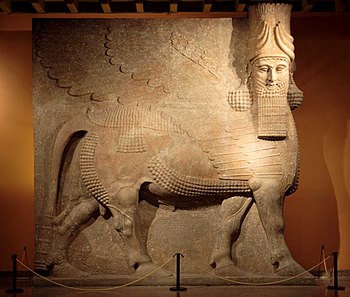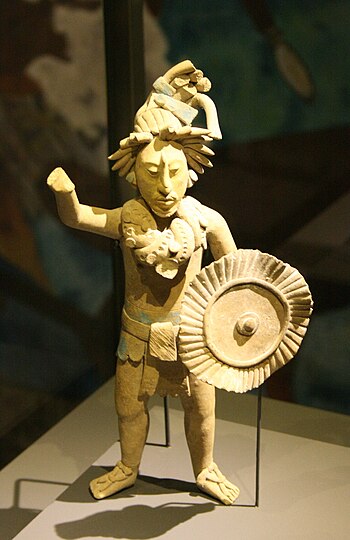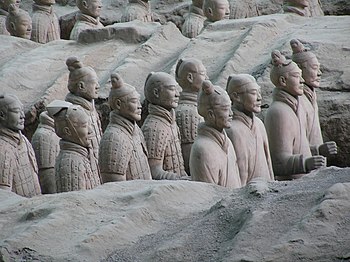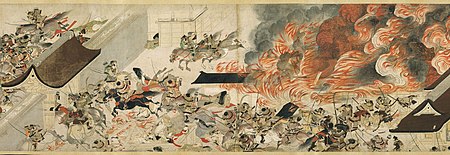Politics, conflict and war
| Art Appreciation and Techniques (#ART100) | |
|---|---|
| Art and our world | Overview | Introduction | Identity | Self-portraits | The natural world | Social and collaborative art | Politics, conflict and war | Memorials | Peace | Summary |
The experiences of politics, conflict and war have been represented in works of art for thousands of years. They become documents, signifiers and symbols for power, remembrance, culture and national pride.
In another subtler example but with no less visual effect, a ceramic Standing Male Warrior from the Mayan culture of Central America (in the photo below left) looks out at the viewer in a stance of informal attention. The figure is only eleven inches high but gives us a trove of information about how Mayan soldiers dressed for battle. A thick vest with detailed patterning covers his torso. A necklace with heavy cupped objects (possibly sea or turtle shells) protects his upper body. The thick belt and loincloth at his waist and the strong bracelets on each wrist add to his protection. The round earrings are typical Mayan accessories. The fingers of his right hand are slightly curled as if he held a club or spear at one time.
For all the restrained beauty in the sculpture, the warrior’s shield and helmet dominate the composition. The shield, held at ease just above the figure’s foot, is embellished with a centralized mask and radiating scallops around the outer edge. The whole shield looks battered and bent from use. The helmet is in the form of an eagle or hawk’s head, surrounded by a heavy necklace of rectangular bars. Vestiges of paint still cling to parts of the sculpture, and it’s easy to imagine how colorful it would have first appeared.
Compare the Standing Male Warrior to the Terracotta Army from China (pictured below right). Discovered in 1974 and dating to the second century BCE, the Chinese figures, all life size, stand in neat rows to guard the nearby tomb of Emperor Qin. In this instance the idea of power and preservation of order is carried into the afterlife. Each soldier’s face is modeled as an individual and their armored robes show lots of detail and patterning. Similar to the Mayan figure, their right hands are curled to hold a club, spear or other kind of weapon.
Nations identify themselves with specific images. A flag is an example that best represents a particular nation. There is symbolic meaning in a flag’s colors, the depicted objects and any text that may be included in them. For example, each white star on the flag of the United States represents one of the fifty states that comprise the nation. In comparison, the flag of Mongolia uses a sky blue central bar, the country’s national color, and incorporates Buddhist religious symbols in yellow on the left.
Until now we have looked at examples that imply war and conflict. Let’s take a look at one that shows the battle as it happens.
The Japanese war epic The Tale of Heiji contains a series of texts and scroll paintings describing the Heiji Rebellion from the tenth century. The scroll section below shows rebels burning the Imperial Sanjo Palace in Kyoto. While flames and smoke rise from the palace the chaos of battle goes on around it. Here war itself becomes the subject matter of the artwork, giving a historical account of the action but also a graphic aesthetic description of the event.
One of the most famous testaments to the horrors of war is Pablo Picasso’s Guernica from 1937. We saw this work in previous modules in the context of how the artist prepared and organized the final painting through sketches, studies and changes in the actual work. Picasso painted Guernica in response to the bombing of the Spanish Basque town by the German air force at the request of Spain’s General Franco during the Spanish Civil War. Picasso shows us a nightmarish scene of death and destruction within an orchestrated chaos of black, white and gray. The bull on the left is interpreted as Franco himself, watching passively over the carnage in front of him. The gored horse near the middle represents the Spanish people – wounded and flailing as they try to resist. A figure thrusts a candle through the open window at the upper right, a reference to the rest of the world as they watch the atrocities taking place. The only direct evidence of battle lies in the dead soldier on the floor, still clutching his broken sword (refer back to the right hands of the Mayan Standing Male Warrior and the figures in the Terracotta Army to see visual comparisons to Picasso’s soldier).
During the 1970’s and 1980’s artist Leon Golub created a series of paintings documenting the abuses that can arise in unstable political climates. Golub’s Mercenaries IV shows soldiers for hire as they call out and taunt each other in an atmosphere of disorder. They lack the discipline of a trained army, and Golub capitalizes on this idea by arranging the figures in a disjointed, asymmetrical composition. His use of a large-scale format (the painting is nearly 8 feet high) and the compliments red and green increases the menace and power of the figures. In the artist’s words:
| “ | The mercenary is not a common subject of art, but is a near-universal means of establishing or maintaining control under volatile or up-for-grabs political circumstances”.[1] | ” |
Notes
- ↑ Leon Golub The Mercenaries, Interview with Matthew Baigell, (1981).





